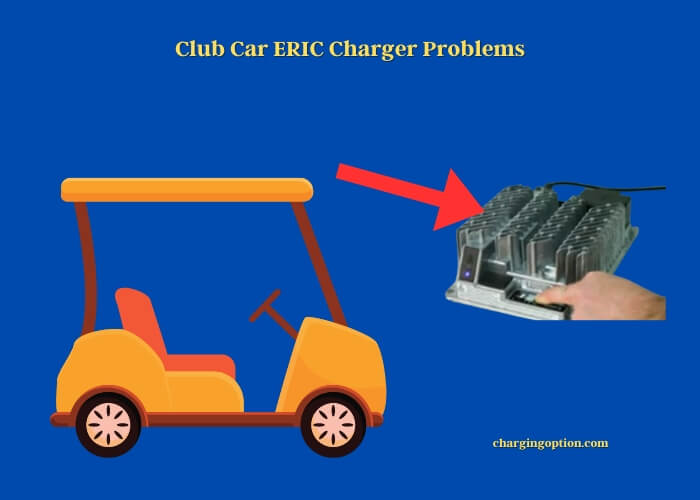Club car ERIC charger problems often stem from various issues linked with battery maintenance, electrical connections, or charger malfunctions.
The primary source of issues can be traced to the battery. Notably, overcharging or undercharging could lead to a slew of problems. Overcharging can cause the battery to deteriorate faster, diminishing its overall life span. On the other hand, undercharging leaves the battery underpowered, impacting the performance of the club car.
Faulty connections play a major role in ERIC charger issues as well. A loose or damaged connection can prevent the charger from functioning properly. Proper attention to maintaining secure and clean connections can alleviate these issues.
The role of the circuit breaker in preventing overloads and short circuits is vital. If it is faulty, it might fail to trip when needed, leading to potential damage to the charger and battery. Similarly, a blown fuse could disrupt the charging process. Both should be regularly inspected for signs of wear and replaced if necessary.
The diagnostics of the charger and its components can help identify issues before they escalate. Early detection of problems such as damaged power cords or incorrect voltage levels can save both time and money in the long run. Constant monitoring of these aspects helps ensure the charger’s efficient operation and the club car’s optimal performance.
Club Car ERIC Charger: An Overview

Club Car ERIC Charger: The Technology
Club Car’s ERIC (Efficient. Reliable. Intelligent. Connected) charger, designed for golf carts, combines a unique blend of high efficiency, intelligence, and reliability. This advanced piece of technology takes charging to the next level, ensuring your cart’s battery is always in top shape.
Typical Usage Scenarios for ERIC Chargers
ERIC Chargers are typically found in golf carts, utility vehicles, and low-speed vehicles (LSVs) that require frequent and reliable charging. By providing efficient and smart charging, ERIC Chargers contribute to the overall performance and longevity of these vehicles.
Necessity of Regular Maintenance and Upkeep
Like any advanced technology, the ERIC charger thrives on regular maintenance. Keeping up with routine checks, cleaning, and scheduled servicing helps to maximize the charger’s lifespan and maintain its performance. It’s a straightforward way to prevent common club car eric charger problems.
Identifying Common Problems with Club Car ERIC Chargers
Recognizing Symptoms of Charger Problems
The first step in fixing any problem is recognizing it. Symptoms of ERIC charger problems can range from the obvious, like the charger failing to charge, to more subtle signs such as irregular voltage or strange noises. Paying close attention to these changes can make the difference in effective troubleshooting.
Diagnostic Tools and Techniques for ERIC Chargers
There are a variety of diagnostic tools available to identify club car eric charger problems. These range from multimeters to check voltage, amperage, and resistance, to specialized diagnostic equipment to read and interpret error codes from the charger itself. By utilizing these tools, one can swiftly identify and rectify any issues.
Problem Symptom vs Possible Cause
| Problem Symptom | Possible Cause |
| Failure to Charge | Faulty wiring or components |
| Charger Overheating | Environmental factors or component failures |
| Fluctuating Voltage | Issues with power supply or internal components |
| LED Light Issues | Error codes or hardware malfunction |
| Strange Noises | Mechanical issues or component failures |
Problem-Solving Guide for Club Car ERIC Chargers
How to Rectify a Failure to Charge
Club car eric charger problems such as failure to charge can often be traced to poor connections or faulty wiring. The first step should be to check all connections, making sure they’re clean and secure. If the problem persists, it could be due to faulty components, which may need replacement.
Strategies to Cool an Overheating Charger
An overheating charger is not just inefficient, but it can also be dangerous. It’s essential to ensure the charger is in a well-ventilated area and is not covered or blocked in any way. If it continues to overheat, professional inspection is advisable to rule out internal defects.
Remedies for Voltage Fluctuation
Fluctuating voltage can be a sign of power supply issues. Ensure the charger is connected to a stable power source. If the problem continues, there might be internal issues with the charger components, requiring professional help.
Solutions for LED Light Problems
If your ERIC charger’s LED light isn’t working as expected, it might be displaying an error code. Refer to the charger manual to interpret what the light patterns mean. For complex issues, consider reaching out to a service professional.
Steps to Quieten a Noisy Charger
Strange noises from the charger could indicate mechanical issues or component failures. While some noise during charging is normal, excessive or unusual sounds warrant a professional inspection.
Implementing a Routine Care Plan for Your Club Car ERIC Charger
Tips for Prolonged Charger Life
Ensure your ERIC charger is stored in a cool, dry place, away from direct sunlight or heat sources. Clean the charger regularly, removing any dust or debris that could impede airflow and cause overheating. Also, it’s advisable to follow the manufacturer’s instructions for use to extend the charger’s lifespan.
Precautions for Safe Charger Use
Safety should always be the top priority. Never use the charger if the cord or plug is damaged. Avoid overcharging by removing the charger once the battery is fully charged. Always disconnect the charger from the power source before cleaning or maintenance.
A Suggested Maintenance Schedule for Optimal Performance
Regular maintenance helps prevent many common club car eric charger problems. A monthly check of the charger’s physical condition, including the power cord and plug, is advisable. A more thorough inspection by a professional should be done annually or sooner if problems arise.
Recognizing the Limits of DIY Solutions
Identifying the Need for Professional Help
While minor club car eric charger problems can often be addressed at home, certain issues require a professional’s touch. If you’ve tried troubleshooting and the problems persist, it’s time to call in the experts.

How to Find a Reliable Service Provider
Look for service providers with a track record of successfully handling similar charger issues. Online reviews, recommendations from trusted sources, and the provider’s responsiveness to queries can provide insight into their reliability.
What to Anticipate During a Professional Repair Session
During a professional repair, the service provider will likely conduct a thorough assessment of the charger, identify the problem, and then suggest the best solution. They may also provide guidance on preventing future issues and maintaining the charger’s optimal performance.
Choosing Upgrades and Alternatives
Selecting a Replacement Charger
If your current ERIC charger is beyond repair, or if you’re simply looking for an upgrade, consider your usage patterns and specific needs before buying a new charger. Research different models, check reviews, and compare features to make an informed decision.
Available Upgrades for Enhanced Performance
Upgrades can offer improved performance and additional features. Some upgrades include high-efficiency chargers and those with advanced diagnostics. Weigh the pros and cons to decide if an upgrade is right for you.
Upgrade Option vs Pros & Cons
| Upgrade Option | Pros | Cons |
| High-Efficiency Chargers | Better charging speed and efficiency | Might be more expensive |
| Chargers with Advanced Diagnostics | Easier problem diagnosis and prevention | Might require technical understanding |
FAQs
What Can Cause Golf Cart Batteries to Be Dead and Not Charge?
Golf cart batteries may fail to charge due to several reasons, including old or damaged batteries, faulty wiring, issues with the charger itself, or environmental conditions like extreme cold.
Can the methods used to solve ERIC charger problems also be applied to other club car charging problems?
When encountering ERIC charger problems, it’s worth examining if the effective solutions for club car charging issues can be applied. However, it is important to evaluate whether the underlying causes are similar and if the remedies suggested for club car charging problems are applicable in this specific scenario. Thorough analysis and expert advice can facilitate successful resolutions.
Why Might the ERIC Charger Fuse Blow?
A fuse in an ERIC charger can blow due to an overcurrent condition, often caused by a power surge or short circuit. It’s a safety mechanism to protect the rest of the charger’s components from damage.
Why Is My Club Car ERIC Charger Unable to Complete a Charge?
If your ERIC charger fails to complete a charge, it may be due to problems with the charger’s internal components, an unstable power source, or issues with the battery being charged, such as age or damage.
Where Are the Fuses Located on a Club Car Golf Cart?
The fuses in a Club Car golf cart are usually located under the seat or the front cowl. Refer to your golf cart’s manual for the exact location and always remember to disconnect the battery before accessing the fuses.
What Does a Yellow Light Indicate on a Club Car ERIC Charger?
A yellow light on a Club Car ERIC charger typically signifies a fault or error. The exact meaning can vary based on the light’s pattern or blink rate. Consult your charger’s manual for specific interpretations.
Why Is My ERIC Charger Flashing Orange?
An orange flashing light on an ERIC charger usually represents an abnormal condition such as a wiring issue, temperature error, or battery fault. The blink pattern can provide more information about the specific problem.
What Do the Lights Mean on a Club Car Charger?
The lights on a Club Car charger serve as indicators of the charger’s status or any potential issues. Colors and patterns can represent different states like charging, fully charged, standby, or error. Always refer to your charger’s manual for specific light interpretations.
Read more:
- Solving the ‘Charged but Won’t Hit’ Issue in nJoy Vape Devices
- Sony WH-1000XM4 Charging Problems: Solutions and Prevention
- Can You Replace the Charging Port on a Nintendo Switch?
- Is It Free to Charge a Tesla Model 3?
- Fixing Your Eufy Robovac: What to Do If It Won’t Charge?
- Fixing the Issue: Kobalt Battery Won’t Charge Guide
Additional Resources
